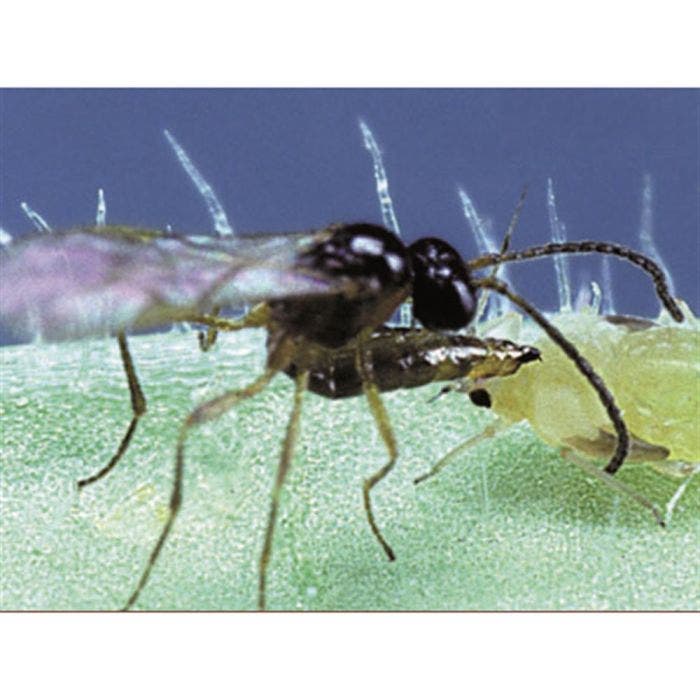Beneficial Insects, BioAphidius Aphid Control by BioBee
Ships Direct 

This item ships directly from our vendor. Please allow additional time for order processing and delivery. For additional details, please contact our customer service department.
In stock
SKU
1545111BBI
$28.30
SEE ALL TIER PRICING
Buy 3 for $27.48 each and save 3%Buy 6 for $26.65 each and save 6%
READ MORE...
Product Information
Direct Shipment Notice
Please note: this item ships directly from the manufacturer, and is excluded from free shipping promotions.
Product Specs
- Species name: Aphidius colemani
- Target pests: Many aphid species including green peach aphids, tobacco aphids, and cotton aphids
- Crops: Vegetables, ornamentals, and more
- Approximate insect count: 500
Product Warranty Information

- This product is covered under A.M. Leonard's exclusive 30-Day Down to Earth Guarantee. Click Here for more Details.
Product Features
- Aphidius colemani
- Easy-to-use distribution method
Product Benefits
- A completely natural aphid control colution
- Temperature-controlled packaging minimizes mortality rate during shipping
- Self-repeating cycle of insect activity ensures continued control
Product Shipping Weight
- 10 pounds
Frequently Asked Questions
1. What is BioBee BioAphidius Aphid Control and how does it work?
BioBee BioAphidius Aphid Control is a beneficial insect package that comprises approximately 500 mummified aphids mixed with fine sawdust. Aphidius colemani, a species of parasitoid wasp that uses around 40 aphid species as hosts during their reproductive cycle, is the main component of this package. To use, hang on plants close to the infested area. Within one to five days, depending on temperatures, the adults will emerge, mate, and hunt for suitable hosts. Two to three weeks after release, you will notice mummified aphids. This mummies will eventually hatch into adults and continue the cycle.
2. Which aphid species can BioBee BioAphidius Aphid Control eliminate?
BioBee BioAphidius Aphid Control can control many aphid species, including green peach aphids (Myzus persicae), tobacco aphids (M. persicae nicotianae), and cotton aphids (Aphis gossypii).
3. What is the optimal temperature range for using BioBee BioAphidius Aphid Control?
The optimal temperature range for using BioBee BioAphidius Aphid Control is between 68 F and 86 F. If temperatures are below 68 F, the adults remain inactive.
4. How to use BioBee BioAphidius Aphid Control for different crops?
BioBee BioAphidius Aphid Control works well for all crops targeted by aphids. Use them with both indoor and outdoor vegetables, ornamentals, and more. Determine your necessary distribution rate based on the nature of the crop and the severity of infestation.
BioBee BioAphidius Aphid Control is a beneficial insect package that comprises approximately 500 mummified aphids mixed with fine sawdust. Aphidius colemani, a species of parasitoid wasp that uses around 40 aphid species as hosts during their reproductive cycle, is the main component of this package. To use, hang on plants close to the infested area. Within one to five days, depending on temperatures, the adults will emerge, mate, and hunt for suitable hosts. Two to three weeks after release, you will notice mummified aphids. This mummies will eventually hatch into adults and continue the cycle.
2. Which aphid species can BioBee BioAphidius Aphid Control eliminate?
BioBee BioAphidius Aphid Control can control many aphid species, including green peach aphids (Myzus persicae), tobacco aphids (M. persicae nicotianae), and cotton aphids (Aphis gossypii).
3. What is the optimal temperature range for using BioBee BioAphidius Aphid Control?
The optimal temperature range for using BioBee BioAphidius Aphid Control is between 68 F and 86 F. If temperatures are below 68 F, the adults remain inactive.
4. How to use BioBee BioAphidius Aphid Control for different crops?
BioBee BioAphidius Aphid Control works well for all crops targeted by aphids. Use them with both indoor and outdoor vegetables, ornamentals, and more. Determine your necessary distribution rate based on the nature of the crop and the severity of infestation.
Write Your Own Review


